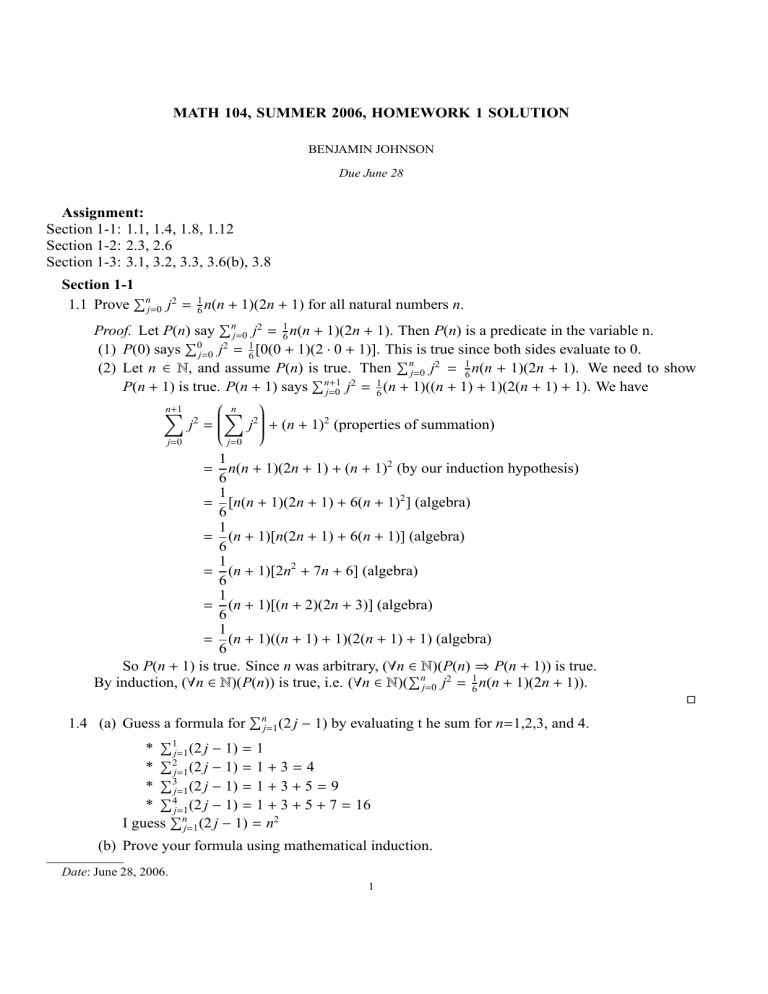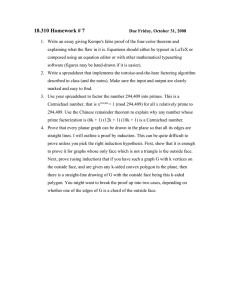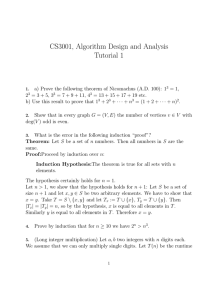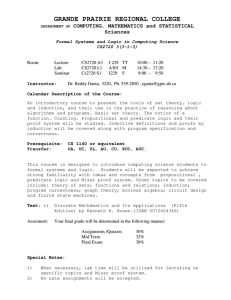
MATH 104, SUMMER 2006, HOMEWORK 1 SOLUTION
BENJAMIN JOHNSON
Due June 28
Assignment:
Section 1-1: 1.1, 1.4, 1.8, 1.12
Section 1-2: 2.3, 2.6
Section 1-3: 3.1, 3.2, 3.3, 3.6(b), 3.8
Section 1-1
P
1.1 Prove nj=0 j2 = 16 n(n + 1)(2n + 1) for all natural numbers n.
P
Proof. Let P(n) say nj=0 j2 = 16 n(n + 1)(2n + 1). Then P(n) is a predicate in the variable n.
P
(1) P(0) says 0j=0 j2 = 61 [0(0 + 1)(2 · 0 + 1)]. This is true since both sides evaluate to 0.
P
(2) Let n ∈ N, and assume P(n) is true. Then nj=0 j2 = 16 n(n + 1)(2n + 1). We need to show
P
1
2
P(n + 1) is true. P(n + 1) says n+1
j=0 j = 6 (n + 1)((n + 1) + 1)(2(n + 1) + 1). We have
n
n+1
X
X
j2 + (n + 1)2 (properties of summation)
j2 =
j=0
j=0
1
= n(n + 1)(2n + 1) + (n + 1)2 (by our induction hypothesis)
6
1
= [n(n + 1)(2n + 1) + 6(n + 1)2 ] (algebra)
6
1
= (n + 1)[n(2n + 1) + 6(n + 1)] (algebra)
6
1
= (n + 1)[2n2 + 7n + 6] (algebra)
6
1
= (n + 1)[(n + 2)(2n + 3)] (algebra)
6
1
= (n + 1)((n + 1) + 1)(2(n + 1) + 1) (algebra)
6
So P(n + 1) is true. Since n was arbitrary, (∀n P
∈ N)(P(n) ⇒ P(n + 1)) is true.
By induction, (∀n ∈ N)(P(n)) is true, i.e. (∀n ∈ N)( nj=0 j2 = 61 n(n + 1)(2n + 1)).
P
1.4 (a) Guess a formula for nj=1 (2 j − 1) by evaluating t he sum for n=1,2,3, and 4.
P
* 1j=1 (2 j − 1) = 1
P
* 2j=1 (2 j − 1) = 1 + 3 = 4
P
* 3j=1 (2 j − 1) = 1 + 3 + 5 = 9
P
* 4j=1 (2 j − 1) = 1 + 3 + 5 + 7 = 16
P
I guess nj=1 (2 j − 1) = n2
(b) Prove your formula using mathematical induction.
Date: June 28, 2006.
1
2
BENJAMIN JOHNSON
P
Proof. Let P(n) say nj=1 (2 j − 1) = n2 . Then P(n) is a predicate in the variable n.
P
(1) P(1) says 1j=1 (2 j − 1) = 12 . This is true since both sides evaluate to 1.
P
(2) Let n ∈ N∗ , and assume P(n) is true. Then nj=1 (2 j − 1) = n2 . We need to show P(n + 1)
P
2
is true. P(n + 1) says n+1
j=1 (2 j − 1) = (n + 1) . We have
n
n+1
X
X
(2 j − 1) = (2 j − 1) + 2(n + 1) − 1 (properties of summation)
j=1
j=1
2
= n + 2(n + 1) − 1 (by our induction hypothesis)
= n2 + 2n + 1 (algebra)
= (n + 1)2 (algebra)
So P(n + 1) is true. Since n was arbitrary, (∀n ∈ N∗ )(P(n) ⇒ P(n + 1)) is true.
P
By induction, (∀n ∈ N∗ )(P(n)) is true, i.e. (∀n ∈ N∗ )( nj=1 (2 j − 1) = n2 )
Note: The formula is true at 0 as well, provided that we adopt the convention that any summation in which
P0 the bottom index exceeds the top index is the empty sum, which is always
zero. [e.g. j=1 (anything) = 0].
1.8 (a) Prove that n2 > n + 1 for all integers n ≥ 2.
Proof. Define N2 = {n ∈ N : n ≥ 2}.
Let P(n) say n2 > n + 1. Then P(n) is a predicate in the variable n.
(1) P(2) says 22 > 2 + 1. This is true since 4 > 3.
(2) Let n ∈ N2 and assume P(n) is true. Then n ≥ 2 and n2 > n + 1. We need to show
P(n + 1) is true. P(n + 1) says (n + 1)2 > (n + 1) + 1. We have
(n + 1)2 = n2 + 2n + 1 (algebra)
> (n + 1) + 2n + 1 (by our induction hypothesis)
> (n + 1) + 1 (since n ≥ 2 and hence 2n > 0)
So P(n + 1) is true. Since n was arbitrary in N2 , (∀n ∈ N2 )(P(n) ⇒ P(n + 1)) is true.
By induction, (∀n ∈ N2 )(P(n)) is true, i.e. (∀n ∈ N2 )(n2 > n + 1)
(b) Prove that n! > n2 for all integers n ≥ 4.
Proof. Let N4 = {n ∈ N : n ≥ 4}.
Let P(n) say n! > n2 . Then P(n) is a predicate in the variable n.
(1) P(4) says 4! > 42 . This is true since 24 > 16.
(2) Let n ∈ N4 and assume P(n) is true. Then n ≥ 4 and n! > n2 . We need to show P(n + 1)
is true. P(n + 1) says (n + 1)! > (n + 1)2 . We have
(n + 1)! = n! · (n + 1) (def of !)
> n2 · (n + 1) (by our induction hypothesis)
> (n + 1) · (n + 1) (by part (a), since n > 4 and hence n > 2)
= (n + 1)2
So P(n + 1) is true. Since n was arbitrary in N4 , (∀n ∈ N4 )(P(n) ⇒ P(n + 1)) is true.
MATH 104, SUMMER 2006, HOMEWORK 1 SOLUTION
3
By induction, (∀n ∈ N4 )(P(n)) is true, i.e. (∀n ∈ N4 )(n! > n2 )
1.12 (a) Verify the binomial Theorem for n = 1, 2, and 3.
Note: In summation notation, the binomial theorem says (a + b)n =
Pn n
k=0 k
an−k bk .
1
1
P1 1 1−k k
1−0 0
1−1 1−0
a
b
+
a
b
=
b
k=0 k a
0
2
2
2 1
P 2−2 2
2−1 1
2−0 0
2
2
2
(2) (a + b) = a + ab + b = 0 a b + 1 a b + 2 a b = 2k=0 2k a2−k bk
(3) (a + b)3 = a3 + 3a2 b + 3ab2 + b3 = 30 a3−0 b0 + 31 a3−1 b1 + 32 a3−2 b2 + 33 a3−3 b3 =
P2 2 2−k k
b
k=0 k a
(1) (a + b)1 = a + b =
(b) Show that
n
k
+
n
k−1
=
n+1
k
for all k ∈ N∗ .
Proof.
!
!
n!
n
n
n!
=
+
+
k−1
k
(k)!(n − k)! (k − 1)!(n − k + 1)!
n!(n − k + 1) + n!k
=
k!(n − k + 1)!
(n + 1)!
=
k!(n + 1 − k)!
!
n+1
=
k
(c) Prove the Binomial Theorem using mathematical induction and part (b).
Proof. Let P(n) say (a + b)n =
(1) P(0) says (a + b)0 =
Pn n n−k k
b . Then P(n) is a predicate in the variable n.
k=0 k a
P0 0 0−k k
b . This is true since both sides evaluate to 1.
k=0 k a
4
BENJAMIN JOHNSON
P (2) Let n ∈ N, and assume P(n) is true. Then (a + b)n = nk=0 nk an−k bk . We need to show
P n+1 n+1−k k
b . We have
P(n + 1) is true. P(n + 1) says (a + b)n+1 = n+1
k=0 k a
(a + b)n+1 = (a + b)(a + b)n (properties of exponentiation)
!
n
X
n n−k k
= (a + b)
a b (by our induction hypothesis)
k
k=0
!
!
n
n
X
X
n n−k k
n n−k k
=a
a b +b
a b (distribute the a and b)
k
k
k=0
k=0
!
!
n
n
X
n n+1−k k X n n−k k+1
a b (bring a, b inside the sums)
a
b +
=
k
k
k=0
k=0
!
!
n
n+1
X
n n+1−k k X n
=
a
b +
an−k+1 bk (index shift the second sum)
k
k−1
k=0
k=1
!
!
n
n
X
n n+1−k k X n
n+1
=a +
a
b +
an+1−k bk + bn+1 (pulling terms from the sum)
k
k
−
1
k=1
k=1
!#
n " !
X
n
n
an+1−k bk + bn+1 (combining the two sums)
+
= an+1 +
k
−
1
k
k=1
!
n
X
n + 1 n+1−k k
n+1
a
b + bn+1 (by part (b))
=a +
k
k=1
!
n+1
X
n + 1 n+1−k k
a
b (bringing outside terms back into the sum)
=
k
k=0
So P(n + 1) is true. Since n was arbitrary, (∀n ∈ N)(P(n) ⇒ P(n + 1)) is true.
P By induction, (∀n ∈ N)(P(n)) is true, i.e. (∀n ∈ N)((a + b)n = nk=0 nk an−k bk ).
Section 1-2 √
1
2.3 Show that (2 + 2) 2 does not represent a rational number.
h
√ 1 i2
√
√ 1
Proof. If (2 + 2) 2 were rational, then so would be (2 + 2) 2 − 2 = 2. (This is because -2
is a rational √
number, and rational numbers are closed under
and addition.) We’ve already
√ squaring
1
shown that 2 is not rational. Thus neither can be (2 + 2) 2 .
2.6 Discuss why 4 − 7b2 must be rational if b is rational.
Rational numbers are closed under the operations of addition, multiplication, and taking integer
exponents, as can be seen from the definitions of +, ·, and n on Q.
(1) ba + dc = ad+bc
bd
ac
(2) ba · dc = bd
n
n
(3) ba = ban
Section 1-3
3.1 (a) Which of the properties A1-A4, M1-M4, DL, O1-O5 fail for N?
Well, for N∗ , A3, A4, and M4 fail. For N0 , only A4 and M4 fail.
MATH 104, SUMMER 2006, HOMEWORK 1 SOLUTION
5
(b) Which of these properties fail for Z?
Only M4.
3.2 (a) The commutative law A2 was used in the proof of (ii) in theorem 3.1. Where?
The proof in the book proceeds from a · 0 = a · 0 + a · 0 to 0 + a · 0 = a · 0 + a · 0 in a single
step. The implied assertion a · 0 = 0 + a · 0 is not justified directly by the axioms because
A3 tells us only that 0 is a right additive inverse, (e.g. a · 0 = (a · 0) + 0), not a left additive
inverse. Additive commutativity (A2) is needed to show that 0 is also a left additive inverse,
or to formally justify the book’s implied assertion.
(b) The commutative law A2 was also used in the proof of (iii) in theorem 3.1. Where?
The book’s proof goes directly from the assertion ab + (−a)b = ab + (−(ab)) to the assertion
(−a)b = −(ab) citing Theorem 3.1(i). But the theorem only allows cancelation on the right.
Extending the result to left cancelation requires two applications of additive commutativity
(A2).
3.3 Prove (iv) and (v) of Theorem 3.1.
(iv) (−a)(−b) = ab for all a, b.
Proof. Let a, b be any elements in any ordered field.
(−a)(−b) + (−ab) = (−a)(−b) + (−a)b (by Theorem 3.1 (iii))
= −a((−b) + b) (by DL)
= −a(b + (−b)) (by A2)
= −a · 0 (by A4)
= 0 (by Theorem 3.1(ii))
= ab + (−ab) (by A4)
So (−a)(−b) + (−ab) = ab + (−ab). By the additive cancelation law, (Theorem 3.1(i)), we have
(−a)(−b) = ab.
(v) ac = bc and c , 0 imply a = b.
Proof. Let a, b, c be any elements in any ordered field F, with ac = bc and c , 0. By A3,
there is an element c−1 in F with c · c−1 = 1. So
a = a · 1 (by M3)
= a · (c · c−1 ) (by M4)
= (a · c) · c−1 (by M1)
= (b · c) · c−1 (by assumption)
= b · (c · c−1 ) (by M1)
= b · 1 (by M4)
= b (by M3)
Pn
Pn
3.6(b) Use induction to prove j=1 a j ≤ j=1 |a j |.
P
P
Proof. Let P(n) say nj=1 a j ≤ nj=1 |a j |. Then P(n) is a predicate in the variable n.
6
BENJAMIN JOHNSON
P
P
(1) P(1) says 1j=1 a j ≤ 1j=1 |a j |. This is true since both sides evaluate to |a1 |.
P
P
(2) Let n ∈ N∗ , and assume P(n) is true. Then nj=1 a j ≤ nj=1 |a j |. We need to show P(n + 1) is
Pn+1
P
true. P(n + 1) says n+1
j=1 |a j |. We have
j=1 a j ≤
n
n+1
X
X
a j = a j + an+1 (properties of summation)
j=1
j=1
≤
n
X
j=1
a j + |an+1 | (by Theorem 3.5 (iii) - the triangle inequality)
≤
n
X
|a j | + |an+1 | (by our induction hypothesis)
=
n+1
X
|a j | (properties of summation)
j=1
j=1
∗
So P(n + 1) is true. Since n was arbitrary, (∀n ∈ N
)(P(n) ⇒PP(n + 1)) is true.
∗
∗ Pn
By induction, (∀n ∈ N )(P(n)) is true, i.e. (∀n ∈ N )( j=1 a j ≤ nj=1 |a j |)
3.8 Let a, b ∈ R. Show that if a ≤ b1 for every b1 > b, then a ≤ b.
Proof. Let a, b ∈ R. Assume for all b1 > b in R we have a ≤ b1 .
We want to prove a ≤ b. To get a contradiction, assume b < a. Then (by what was proven in
class) there is a real number c with b < c < a. Since c > b, our hypothesis tells us a ≤ c. But we
already said c < a. This is a contradiction, showing that b < a is impossible. So we must indeed
have a ≤ b.



